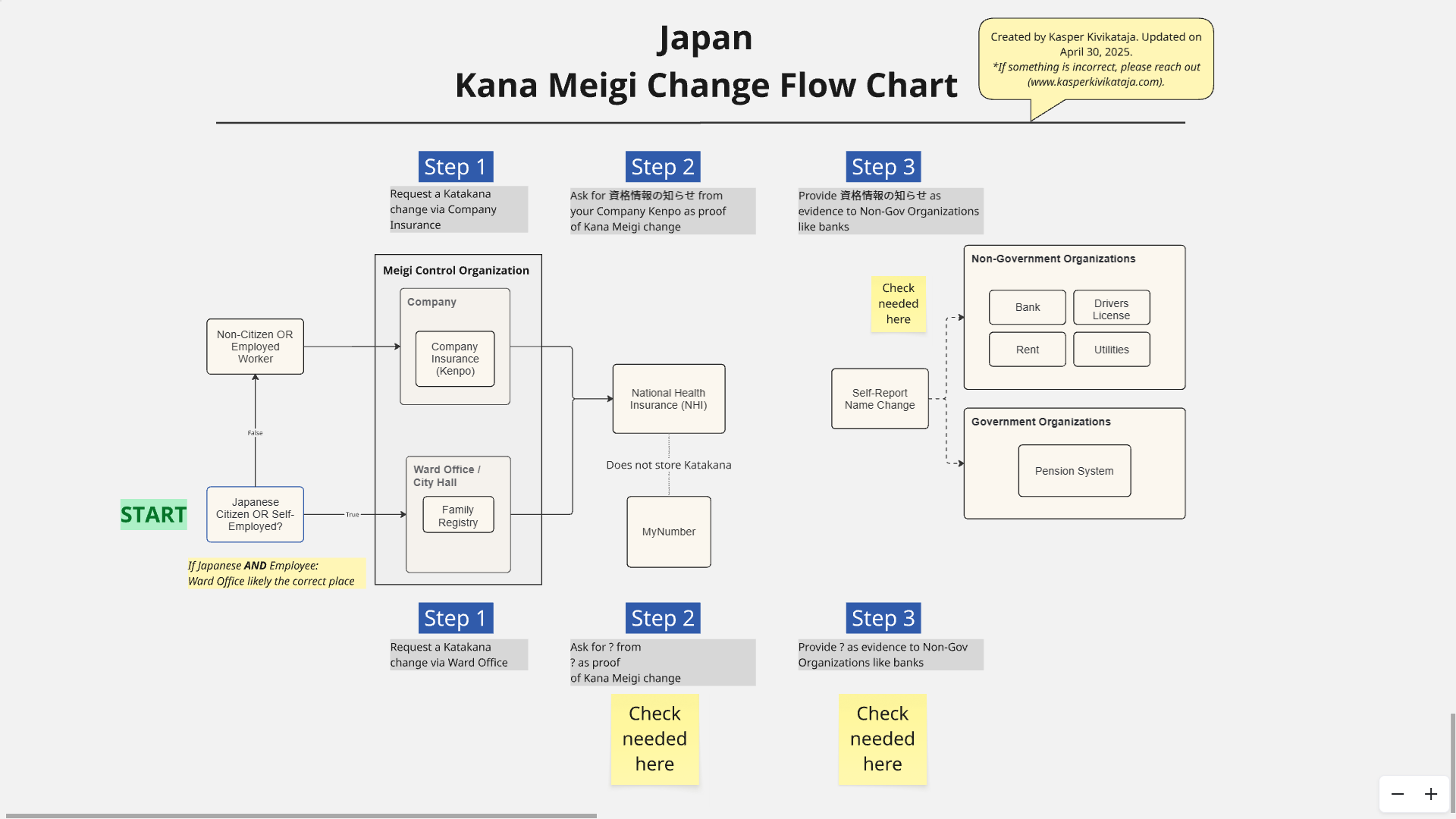Intro
Recently, I tried buying stocks using a credit card from my investment account to earn some extra points. However, when I attempted to link the trading platform with my credit card, I was met with an error: my meigi name didn’t match. That error kicked off a month-long journey to update my katakana name — in a way that even Japan’s legacy systems would accept. Yes, surprisingly, there are “wrong” ways to write your name in katakana, even though it’s an official Japanese script. In this blog post, I’ll walk you through every step I took. I’ve also included a flowchart at the end to help explain the tangled web of how Japanese systems handle names.
*This post will be updated from time to time to reflect new information.
Basics
To start off with some basics: when moving to Japan, you get to choose how your name is written in Japanese (and thus pronounced in katakana). This is typically first decided when opening a bank account.
Below is a chart of the writing systems:
| Writing System | Accepted? | Notes |
| Kanji | Not for foreigners | Foreigners cannot register names in kanji unless it’s legally part of their name (rare). |
| Katakana | Yes | Used for foreign residents; accepted on legal documents like Zairyu cards. |
| English (Latin) | Sometimes | Some banks or private systems may allow both, but it’s case-by-case. |
I’ve gathered a few basic points about katakana names:
- Katakana represents the pronunciation of your legal name, whether it’s written in English or Kanji.
- While a katakana name is not a legal name, it should generally match the name on your passport — including any middle names.
- Be careful how you write it: using the “wrong” version can cause issues in some systems. (More on this later.)
The Problem
Meigi (名義) is an important concept in Japan. It refers to the name under which something is registered, and it’s usually the same as your legal name. For native Japanese people, meigi is often written in kanji, though katakana is commonly used in banking. For foreigners, meigi is typically written in katakana, but sometimes in English (Latin letters).
From my experience — especially with banking — katakana is heavily used, regardless of your background.
In financial systems, the meigi is a critical string of text used for verification. If the name doesn’t match exactly across systems, you’ll likely encounter errors — as I did.
One common issue is length. Many systems have strict field limits, since Japanese names tend to be short and don’t include middle names. Still, even if you want to shorten your name, banks often require you to include all names as written in your passport.
Another issue is how you write the name — that is, the encoding.
My first name is Kasper. In katakana, it could be written as:
カスパー
キャスパー
カスペル
However, the “ー” (long vowel marker) often causes problems in older systems that still use legacy encodings like JIS X 0201 / 0208. For this reason, writing it as カスペル turned out to be the most stable and widely accepted option.
Changing Katakana Name
I marched to the bank (SMBC – 三井住友銀行) with my legal documents in hand — including my passport and residence card, arguably the highest forms of identification one can hold in Japan. I was asked to provide evidence of the new katakana spelling of my name.
When I asked what kind of evidence was acceptable, I was told a Certificate of Residence (住民票) would work. So off I went to the ward office. There, I was told that while changing your katakana name is not an issue, it will not appear on any official document — at least within Tokyo’s 23 wards. The staff member was kind enough to call the bank on my behalf to explain this, but despite her effort, the bank still did not offer a solution.
That left me stuck: I had no way to prove my updated katakana name.
After weeks of digging, I finally found the answer. The process depends on your situation. In my case, as a company employee, I was able to change my katakana name through my company’s health insurance provider (健保). Shortly after, I received a paper called 資格情報の知らせ, which confirmed the change — and the bank accepted it.
I’ve drafted a flow chart outlining how katakana name changes work. It’s still a work in progress, but I’ll continue updating it as I learn more.
